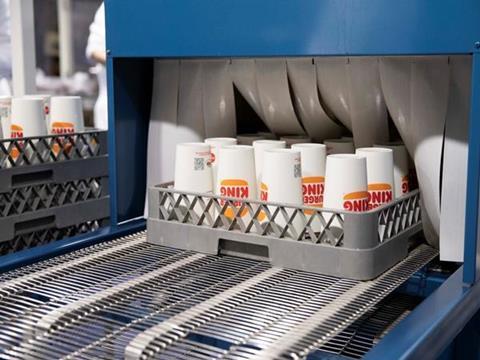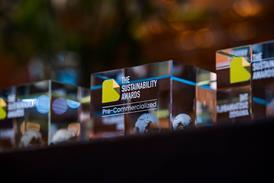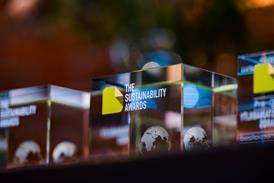
In a rush? Click here to read a short summary of this report
As European legislation ramps up pressure to cut packaging waste, the Nordic Co-operation has investigated whether reusable or single-use packaging offers a lower environmental impact in real-world settings. This report digs into comparative life cycle assessments (LCAs) for takeaway, e-commerce, and healthcare packaging to offer clear insights for businesses navigating sustainability choices.
-
Reusable takeaway containers win – if used enough: Reusable food containers outperformed single-use options in 11 of 13 environmental categories, but only when used at least 6 times (ideally 14). Strategic design and consumer incentives are essential to unlock these benefits.
-
E-commerce results are mixed: Surprisingly, single-use plastic bags had a lower environmental impact than reusables in most categories. Reusables only became favourable with high reuse rates (18+ uses), light materials, and efficient logistics.
-
Paper isn’t always better: Single-use paper packaging underperformed in most impact categories compared to both reusables and single-use plastic, challenging common assumptions about eco-friendliness.
-
Context is key: Packaging performance varies by sector, material, usage rates, and local conditions. One-size-fits-all solutions don’t apply; each use case must be evaluated individually.
-
Healthcare adds complexity: Hygiene and logistics concerns limit the practicality of reusables in healthcare. While some LCAs show reusables outperforming single-use systems, others highlight operational and patient-care drawbacks.
Reusable packaging can deliver significant environmental benefits, but only when reuse systems are designed and executed effectively. The Nordic study shows that switching from single-use to reusable isn’t automatically better; real sustainability gains depend on how often items are reused, how they’re made, and how they’re handled. Businesses should focus on reducing material use, optimizing logistics, and aligning with sector-specific needs to meet both climate goals and practical constraints.
This article was created for Packaging Europe members – but we’re making it free so you can get a taste of what our membership package offers.
Members get access to two articles like this per month, plus a monthly in-depth report and plenty of other benefits, giving you essential insights into the most important packaging news and developments. Click here to learn more about becoming a Packaging Europe member.
What has a lower environmental impact – single-use packaging, or reusable alternatives? In this edition of The Brief, we take a look at the Nordic Co-operation’s in-depth investigation into disposable versus washable food and e-commerce packaging, before extending our query into the healthcare sector.
In its policy review, the Nordic Co-operation observed that the European Commission is introducing legislative measures to lessen packaging waste and drive uptake in reusables across various industries. Industry players are facing increasing pressure to transition into environmentally conscious materials and designs – but what exactly that looks like, and how to do it in practice, can be difficult to pinpoint in the vast array of contexts in which we use packaging.
Research and testing can be helpful in gauging which solutions are appropriate and where. For instance, in a collaboration between Norwegian, Swedish, Danish, Icelandic, and Faroese stakeholders, Danske Regioner revealed its Nordic Criteria for More Sustainable Packaging for Healthcare Products in 2022 – circulated for consultation in Norway and Denmark and in the framework of the European industry association MedTech Europe.
A scoring model – taking the form of a spreadsheet with a user guide and method instructions provided – is used to convert the total climate and environmental impact of a packaging design into one score. Customers are to provide the weight, materials, and other information about the elements of their packaging; in the case of reusable elements, the model attributes a weight of 0g. At this point, the score is calculated based on integrated index values for different material types. The higher the score, the more positive the assessment.
According to Danske Regioner, its sustainability criteria are designed to complement the European Packaging and Packaging Waste Directive and “support a cost-effective change towards more climate and environmentally sustainable packaging for healthcare products.” They are split into basic criteria, or the “starting point”; advanced criteria, for higher climate and environmental performance; and spearhead criteria, for “excellent” performance.
On a broader scale, though, the European Commission’s Environmental Footprint life cycle impact assessment method quantifies a product or company’s environmental impacts and helps reduce them. Its latest update from July 2022, EF 3.1, applies to the characterization factors in the Climate Change, Acidification Ecotoxicity freshwater, Photochemical ozone formation, Human Toxicity cancer, and Human Toxicity non-cancer categories, and forms the basis of the Nordic Co-operation’s investigation into takeaway food and e-commerce packaging.
Although they acknowledged previous studies’ suggestions that reusable alternatives are generally more environmentally friendly than single-use packaging – an outcome attributed to its multiple use cycles, lowered transport differences, packaging weight, material choice, and recycled content – the Nordic Co-operation’s researchers noted an absence of literature specifically comparing reusable and single-use packaging in the Nordic region.
Therefore, the Nordic Working Group for Circular Economy (NCE) under the Nordic Council of Ministers commissioned a study to weigh up the advantages and setbacks of reusable packaging in the area. Although it does not consider its findings definitive, the Nordic Co-operation also intends to provide an ‘informative guidepost’ with such information as the recommended number of reuses for reusable solutions, which could then steer businesses and authorities alike towards more environmentally conscious decision-making.
The methodology
The following types of packaging were considered as part of the study:
- Reusable takeaway container – 226g polypropylene reference flow per unit; 26g virgin polypropylene reference flow per functional unit; 1.25 litre capacity; 10 uses.
- Single-use, disposable takeaway container – 59g polypropylene reference flow per unit; 59g virgin polypropylene reference flow per functional unit; 1.25 litre capacity; 1 use.
- Reusable e-commerce packaging – 118g woven polypropylene reference flow per unit; 29.5g virgin, woven polypropylene reference flow per functional unit; 21 litre capacity; 4 uses.
- Single-use, LDPE film e-commerce packaging – 12g LDPE reference flow per unit; 12g virgin LDPE reference flow per functional unit; 21 litre capacity; 1 use.
- Single-use, paper e-commerce packaging – 65g corrugated cardboard reference flow per unit; 65g corrugated cardboard reference flow per functional unit; 21 litre capacity; 1 use.
A Life Cycle Assessment (LCA) was carried out to assess the environmental impact of each pack, spanning every stage from cradle to grave.
To adequately compare the different materials and weights of single-use and reusable containers, the researchers calculated the so-called ‘functional unit’. For takeaway containers, this was defined as the unit required to contain and protect one 1.25 litre restaurant meal for a single use in one of the Nordic countries; in e-commerce packaging, it was the unit needed to contain and protect one shipment of clothes with a maximum capacity of 21 litres for one delivery within the region.
Although it evaluates thirteen impact categories in line with Environmental Footprint 3.1, the results could not be normalized or weighted “due to the comparative nature of the assessment”. It was also emphasized that the results could not be compared across impact categories.
For the purposes of this study, the researchers decided to study food containers made of plastic. The decision was based on a rating matrix weighing up their adherence to current or future regulations, their potential to reduce waste, the feasibility of their technical implementation, and the possibility that the research could reveal new findings.
In an e-commerce context, plastic bags were assumed to have more longevity in a reuse system due to their strength in comparison with fibre-based options. As such, the researchers chose to examine a reusable bag made of woven polypropylene, comparing it to conventional single-use plastic and paper bags.
Both takeaway and e-commerce reuse systems were examined as if the pickup and return points were the same distance away from the consumer. It was taken as a given that the reusable takeaway container would be washed by the user before it was returned, and that the service point (i.e. a restaurant) would wash it again with a professional dishwasher. Reuse rates were placed at 90% for the takeaway containers and 75% for the e-commerce packaging; these were tested with a break-even analysis.
Takeaway containers
A comparative LCA of the takeaway packaging options revealed that, in general, reusables were less impactful in eleven out of thirteen impact categories. Their environmental impacts were found to be spread across the stages of their life cycle, whereas single-use alternatives saw more impacts arise in the raw material extraction and manufacturing stages.
Relatively speaking, the environmental benefits of reusable containers included the weight of the containers, their end-of-life modelling parameters, and consumer behaviour – for example, avoiding pre-washing during the packaging’s use, or avoiding energy-intensive transport methods.
It was found that a minimum of six uses were needed to reach the ‘environmentally preferred break-even point’ – yet, to ensure that every impact category benefits, fourteen uses were required. Transporting the packaging via low-carbon or zero-emission methods and avoiding unnecessary cleaning were also recommended as ways of reducing impact.
In the takeaway sector, then, reusable packaging came out on top. The Nordic Co-operation recommended that reusable containers be well-planned and strategically designed in order to achieve success. Guidelines and incentives were expected to encourage consumers to return their containers quickly, avoid washing containers unnecessarily, and other beneficial behaviours.
E-commerce packaging
Conversely, single-use plastic packaging yielded lower impacts than reusables in most environmental categories in e-commerce applications, although the same could not be said for single-use paper. Single-use plastics were found to be beneficial in thirteen categories, twelve of them highly robust; yet paper only offered environmental benefits in five categories, and most of them only achieved medium robustness.
Extracting raw materials, manufacturing, and other upstream life cycle stages were said to be the biggest contributors to the environmental impacts in both single-use and reusable packaging systems. For single-use, raw material extraction hit the environment the hardest, followed by distribution. Manufacturing was ‘relatively more dominant’ in its impact on reusables, the study found, with incorporated reverse logistics also causing more damage in the usage phase.
Reuse systems were also said to beat the environmental efficiency of single-use paper in eight out of thirteen categories, with six of them demonstrating high robustness. The transportation process was described as having ‘minimal impact’ on the results, although the number of reuse cycles did contribute; the more a pack was reused, the lower its impact per use.
As such, high reuse rates were encouraged to maximize the environmental benefits of a reuse system. The study set a baseline reuse rate of 75%, or four uses, although the researchers felt that raising the number up to 18 uses or cutting down on upstream impacts could change the outcome in reusable systems’ favour in most impact categories.
Expanding outwards
Broadly speaking, reusable packaging was found to reduce environmental impacts when compared to single-use alternatives, assuming that the corresponding reuse systems were implemented correctly. Nordic Co-operation believed that continual improvements – even those extending beyond the limits of the study, like removing packaging altogether where appropriate – would continue to benefit the environmental performance of packaging on the market.
The researchers emphasized that, in practice, a range of context-dependent and circumstantial variables played into the study’s outcome – recommending that its findings should be referenced “cautiously, considering the possible variability of each unique situation.” The nature of the companies utilizing the packaging, the packaging manufacturers, and the intended users should all be considered when deciding between single-use and reusable packaging.
When adopting reuse over single-use, the researchers recommended that manufacturers consider the weight (particularly its lightness), durability, recyclability, and use of recycled materials of a reusable pack. Reuse systems should be efficient and incentivize consumers to participate, both by opting to use reusable packaging and returning it afterwards. If this is done correctly, Nordic Co-operation argued that the Nordic region could improve its sustainability metrics.
On a continental scale, the researchers added, keeping supply chains local and securing less energy-intensive transport could be beneficial for reducing the environmental impact of packaging. Appropriately separating and treating waste at the end of its life was also uplifted as the path towards circularity, and therefore the key to a reduced environmental impact.
The Nordic Criteria for More Sustainable Packaging for Healthcare Products makes its own, broader observations. Biobased packaging, for instance, is thought to reduce reliance on fossil fuels – but it may have the unintended consequence of disrupting the food chain by consuming raw materials like maize, the guidelines warn. Instead, they assert that cutting down on unnecessary material is “usually the most effective measure”, as it reduces resource consumption and waste volumes. Designing packaging for sorting and recycling is also thought to be beneficial.
Little is said about reusables, but opinions vary across the sector. Ambu, for example, focuses its efforts on single-use endoscopy, anaesthesia, and patient monitoring solutions – integrating bioplastics into products and packaging, avoiding PVC, partnering on recycling initiatives and pilot projects, and considering alternative ways to ship its medical devices.
Its view is that reusable systems (referring here to products, but raising criticisms that could also apply to packaging) are “labour-intensive” and “require increasingly complex reprocessing” due to strict hygiene regulations, with delays, equipment downtime, and staff shortages all contributing to negative impacts on patient care. Ambu Nordic asserts that the entire lifespan of its single-use aScope 4 Cysto has a lower environmental impact than a reusable cystoscope’s reprocessing stage alone.
On the other hand, another cradle-to-grave LCA assessment – admittedly carried out in the Netherlands rather than the Nordics, although regional differences in the energy mix of washing and sterilization were explored – found that rigid, reusable sterilization containers have an 84% lower environmental burden than single-use polypropylene packaging, or blue wrap. In 5000 hypothetical use cycles, the rigid containers were thought to outperform blue wrap after just 68, although recycling blue wrap in a closed-loop scenario was expected to halve its pollution rates.
Ultimately, the feasibility of reusable packaging, and how it compares to single-use alternatives, is context-dependent. The sector in question plays a role, as do hygiene requirements, the recyclability of the single-use material, and more. Yet, with Finland, Norway, and Sweden occupying the top spots in Robeco’s Spring 2024 Country ESG Report, the region appears to be leading the way in its sustainability progress, and detailed studies like those mentioned above are crucial in making the right decisions.
If you liked this story, you might also enjoy:
How are the top brands progressing on packaging sustainability?
The ultimate guide to global plastic sustainability regulation





















No comments yet